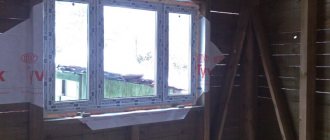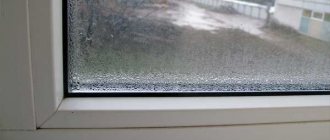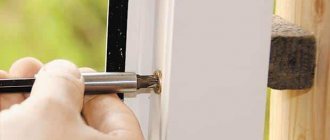How to open plastic doors and windows correctly?
Pivot opening
To open a window sash in a horizontal plane with a turn, you need to turn the handle from the position end down (closed) to horizontal (end to the right), and then pull. To perform the reverse operation, you need to press the sash against the frame, and then turn the handle 90° to its original position.
Flip opening
To perform a folding opening, with the sash pressed, you need to move the handle from the lower to the upper vertical position (turning it 180°), and then open the sash towards yourself. To close, you must first press the frame against the sash, then turn the handle to the down position.
Ventilation / winter opening
To open a window with a slot in order to ventilate or minimize heat loss in winter, you need to move the handle from the top position (for folding opening) to the right side at an angle of 45° with the sash tightly pressed.
Compliance with these conditions will help you choose a comfortable ventilation mode at any time of the year and quickly regulate the temperature in the rooms.
General recommendations
After completing the installation work, remove the protective film from the inside and outside of the window, window sills and slope panels, and corners.
Do not turn the handle when the sash is in the open position.
When carrying out construction and repair work, ensure that window structures are protected from mechanical damage and contact with solvents, cement, paints and other building materials. Opening structural elements are equipped with high-quality fitting mechanisms, which ensures smooth and easy operation and does not require the use of physical effort. If difficulties arise, invite a specialist to identify and eliminate the cause.
Carry out independent maintenance of structures regularly. To carry out this work, it is recommended to use only special care products for fittings, PVC profiles and seals.
Specifics of PVC profile operation
The polyvinyl chloride frame is easy to clean - in most cases it can be washed with plain water and soap or household detergent. Due to the smooth structure of the plastic surface (which compares favorably with cellular wood), cleaning during operation can be done with a sponge or a special household microfiber cloth.
To wash the plastic frame, do not use sponges with a rough surface or cleaning agents that contain coarse crystalline substances and active ingredients: acid, solvents, acetone, etc. The surface of the structure is quite sensitive and the slightest damage on it is immediately noticeable. Before washing, the plastic must be cleaned of dirt and dust, and to wipe it dry, use an antistatic agent in the form of a spray or liquid.
To protect frames, glass and fittings from the consequences of cosmetic repair work: whitewashing walls and floors, puttying and painting walls, screeding and filling the floor, frames must be covered with dense, waterproof material. For such situations, it is best to use regular packaging film, applying it in several layers. If, during long-term use of a plastic window, microscratches still appear on its frame, then the area with them is thoroughly sanded and coated with a polishing compound. Deep flaws and chips are first filled with a quick-hardening solution of an identical color, and then sanded and polished.
Leaf operating modes
The figures show the handle positions for different modes of operation of the sash.
All operations with the window handle should be carried out without excessive force and only with the sash closed.
The sash of the window structure is closed:
The handle is located vertically, the sash is tightly pressed to the frame along the perimeter
The sash of the window structure is fully open in the rotary mode:
The handle is located horizontally
The sash of the window structure is folded back:
The handle is located vertically
The sash of the window structure is open in the slot ventilation mode (micro-ventilation):
The handle is tilted at 45 degrees, the sash is not pressed tightly
Caring for window seals
Inconspicuous seals located around the perimeter of the window and frame play a very important role and require regular maintenance, no less than other structural elements. The insulating characteristics of the window (thermal insulation and sound insulation), as well as its impermeability to moisture, largely depend on the condition of the seals.
Seals do their job well until they crack and lose their elasticity. In order for this to happen as soon as possible, it is recommended to lubricate rubber products twice a year with a special compound.
Silicone or glycerin lubricant for rubber products is applied to the washed but dry surface of the seal and rubbed well with a soft cloth. If you regularly “pamper” your windows with a similar procedure, they will protect your home from cold, noise and heavy rain for a very long time.
Expert commentary
Vladislav Dobronravov
Leading technical specialist at Okna-Media company
Important! Do not wash or lubricate rubber seals with substances containing high concentrations of active chemicals!
Maintaining indoor microclimate
Based on GOST 30494-96 “Residential and public buildings”, SNIP 2.04.05-91 “Heating, ventilation and air conditioning”, as well as the letter of the State Construction Committee of Russia No. 9-28/200 dated March 21, 2002, it is necessary to maintain a certain humidity regime in indoors. The air humidity parameters in a room with PVC windows in winter are 30-40% at a temperature of 20-22 degrees. Such indicators are mandatory, and in order to achieve them and avoid the occurrence of condensation on the windows, it is necessary to follow the recommendations for ventilating the room.
Adjusting the plastic window
adjustment of fittings Initial adjustment of windows is usually carried out by specialists after assembly and installation of the window system. With further use, you can make adjustments yourself. The main problems that can be solved by adjusting the fittings yourself:
- blows from under the seals - it is necessary to adjust the pressure of the fittings. Using a hex wrench, pliers or a screwdriver, tighten all offset bolt pins around the entire perimeter of the valves. As a result, we obtain optimal pressure on the sash and frame;
- the bottom of the sash rubs against the frame - this problem arises due to the sagging of the window sash. To fix the problem, you need to raise the sash using the vertical hinge adjuster or one of the horizontal adjusters;
- the sash touches the frame with its middle part - this is due to the vertical and horizontal displacement of the window sash. The problem is solved by uniformly adjusting the vertical and horizontal adjusters in the required direction.
The need to independently adjust windows arises due to normal shrinkage of the house. When the walls change their position even slightly, the sash begins to loosely adhere to the window frame. This situation is quite normal, especially for new buildings, and is very easy to solve with your own hands.
Ventilation recommendations
Structures made from PVC profiles are sealed and therefore cannot provide natural air exchange. To prevent this advantage from turning into a disadvantage, you should follow the recommendations that will help avoid the formation of condensation in the room:
- the room must be ventilated twice a day for 10-15 minutes; heat loss with such ventilation is insignificant, even in winter
- Ventilate the room as often as possible during the day using micro-ventilation using clamps (combs)
- rooms that are undergoing or have recently undergone renovations, rooms with a large number of flowers and plants need additional ventilation
- the window sill should not block the heating radiator; make sure that the curtains do not prevent the flow of warm air to the window
- It is not recommended to install decorative screens covering heating appliances
Maintenance of drain holes
All plastic windows are equipped with special drainage channels that remove accumulated moisture out.
Such channels are located at the bottom of the frame; they can be detected after opening the window sash.
There are times when the holes, especially after repair work, become clogged with dirt and water begins to flow into the apartment. Therefore, the cleanliness of the holes must be carefully monitored.
It is necessary to clean them from dirt with a piece of loose wire or a vacuum cleaner.
When purchasing plastic windows, you need to check for drainage holes. If they are missing, defective or defective, then operating the windows can become significantly more difficult.
Tips to prevent possible malfunctions
Inspect and clean the drainage holes promptly and thoroughly, remember that they prevent the formation of ice, condensation and moisture from entering the room.
If the window handle is loose, lift the trim underneath, rotate it from vertical to horizontal, and tighten the screws. The handle is fixed again. All operations with the handle should be performed effortlessly with the window sash closed.
Changing the function of the sash when it is open or not tightly pressed to the frame can lead to both rotation and tilt of the sash (double opening). Double opening is caused by improper use of windows. If, as a result of this, the sash remains fixed only on the lower hinge, do the following on your own (you may need the help of a second person):
- With a little force, press the folded upper edge of the sash perpendicular to its surface so that the upper corner of the sash fits the hinge. With one hand, press the locking lever located on the sash in the handle area, and with the other hand, turn the handle to a horizontal position. The restrictive part of the fittings (scissors) will connect. Release the lock lever. The sash operation has been restored.
Safety requirements
In order for the window to serve for a long time and not cause any harm, certain safety requirements must be observed. The operation of window systems must be carried out according to the following rules:
- It is strictly forbidden to exert force when using window elements;
- You cannot put anything unnecessary in the opening of the frame or sash or under the sash;
- it is prohibited to load the window sash with additional loads;
- it is necessary to close the window when there is a draft or wind;
- do not keep your hands in the window opening, otherwise there is a danger of them being pinched;
- there is no need to try to slam or open the doors hard and sharply;
- Mechanical impact on window systems must not be allowed; scratches must be avoided.
At the same time, one of the most important safety measures is the window opening mechanism for the child. It is designed so that the window can not only be opened conveniently, but also to protect children from this possibility. The system that controls the opening has a special lock built into it, which prevents the child from opening the window without the presence of an adult.
Product Description
Window blocks are made of PVC profiles with double-glazed windows and equipped with high-quality fittings. Modern translucent fencing structures using PVC profiles are increasingly used throughout the world.
In terms of their general design, PVC windows are hollow multi-chamber polyvinyl chloride profiles reinforced with steel reinforcing liners. To solve both technical and architectural problems, manufacturers produce a large range of products from which elements of different shapes, sizes, any color and any type of opening can be easily assembled. It is necessary to note one more feature in the design of PVC windows - profiles. Unlike old wooden windows, where the system of double sashes (paired or separate) is widely used, in PVC profile windows a single sash with a double-glazed window is mainly used.
PVC profiles of the opaque part of the window block are multi-chamber (Fig. 1). Different types of profiles may have different numbers of cameras. The multi-chamber structure provides good heat-shielding qualities.
Fig.1 Multi-chamber PVC window profiles.
Inside the PVC profiles, a reinforcing liner made of galvanized steel is installed and secured with screws, which absorbs wind loads and prevents the PVC profiles from bending under the influence of high summer and low winter temperatures.
All connections between the profiles and the glass unit, as well as the opening and non-opening parts of the window unit, are protected by seals made of rubber material – EPDM, continuous along the entire contour. Seals prevent moisture from entering the room and blowing through the window.
A double-glazed window is a sealed structure of two glasses (single-chamber double-glazed window) or three glasses (double-chamber double-glazed window), separated by an aluminum spacer frame connected to the glass using sealant (Fig. 2).
Rice. 2. Double-glazed window design.
- internal butyl sealant (tape or mastic)
- spacer frame (aluminum or galvanized steel profile)
- desiccant (molecular sieve)
- external sealing mastic
- glass
In the standard version, the internal cavity (chamber) of the glass unit contains dried air. Air dehumidification is carried out by silica gel (molecular sieve), located inside a perforated spacer frame and absorbing moisture.
Special metal-coated glass can be installed in a double-glazed window, increasing its heat-shielding qualities or reflecting solar radiation.
Fittings are a set of parts that form a single mechanism along the contour of a window, ensuring its opening and closing. The set of parts can be selected in various ways, so as to provide different opening modes: for washing, for ventilation, for micro-ventilation of the room. All fittings are made of steel with a special anti-corrosion coating.
As often happens, you probably combined the purchase of new windows with the renovation of your apartment (office). New windows not only changed the interior of the room, but also radically changed the conditions of ventilation, heat exchange and microclimate in your apartment.
The new windows provide a very tight seal. They make your home much warmer, protect it from street noise, and save energy needed for heating. On the other hand, they prevent “natural drafts,” which makes it difficult to remove excess moisture from the room and leads to condensation in the coldest places.
Our advice is that apartments (offices) with window blocks made of PVC profiles need more frequent ventilation. The issues of condensation are discussed in more detail in Section 4.1.
Almost all houses have heating radiators under the windowsill. They perform a very important function, heating the window opening. Often when replacing old windows, old narrow window sills are replaced with new wide ones, which impede the convection of hot air from the radiator, and therefore contribute to an increase in humidity. When replacing old window sills, choose a window sill that is proportional to your heating radiator. When choosing the length of curtains and curtains, leave enough space for warm air from the heating radiator to pass through.
Problems with plastic windows
Window fogging
Using plastic windows, you can achieve a high level of tightness, which will retain heat and protect from air flow and dust from the outside. But because of this, moisture is isolated in the room, which can be ventilated through wooden windows with the help of a draft.
Moisture begins to accumulate and settle on objects with low temperatures, especially on the windows and walls of the house that face the street.
Most often this process is facilitated by:
- increased level of humidity - exhaust ventilation in the kitchen, bathroom and toilet is checked using a paper sheet that must be held by the draft;
- insufficient ventilation - the influx of moisture into the room comes from the bathroom, kitchen, watering plants, washing and drying things;
- window installation carried out in a recent period of time. Moisture is released from installation materials for up to three months;
- location of living quarters on the upper floors. Humid air rises, therefore, the higher your apartment is, the higher the humidity of the air space in it;
- covering the radiator with a window sill. The circulation of warm air masses between the window and the radiators is blocked, which contributes to the formation of condensation.
Before installing a window, you need to carefully consider all the nuances that may arise. It is best to replace windows in the warm season, since excess moisture that appears after installing window systems can easily and quickly evaporate.










